

|
|
|
#1
|
|||
|
|||
|
Possible damage from wrong water change
Hello,
I have a 50 gal tank full of SPS that works since 7 years. Until two years ago it has always been good with a great growing rate and beatiful colours, but in the last two years it doesn't go how it should be: low or zero growth, some cyanobacter spot and sometimes some regression of the tissue at the base. Instead SPS colors are ok and all chemical measurement are perfect (PO4, NO3, Mg, Ca, Kh, NH4, Si). I must confess in fact that in the last year, I gradually changed my way to perform water changes: due to lack of time for my job and the need of putting all the salt together in the water (Marine Environement salt) and having a smaller container (60lt instead of 90lt), i used to put in the sump mixed water with higher salinity because i thought that a 10lt change wouldn't have made a great damage. Could it be this the cause of all my problems? And i also wondewr if the RO water in replacement of eveporated water should be of the same temperature and poured into the sump slowly to avoid dameges deriving from different density. By the way your article was great and of sure utility and it's sure that by now, all parameters of newly mixed water will be checked before putting it in the display tank. Thank You. |
|
#2
|
|||
|
|||
|
Hi Ink - If you had a different system in the past and it worked well for you, then you saw a negative impact on your reef with a new method of water changes... yes I would look at going back to what worked well in the past.
Tanks that are over 5 years old have a tendency to decline, often referred to as "old tank syndrome." However, I tend to wonder if it is because the hobbyist becomes lax in how they care for their reef. If the actual case is that the person doesn't change water like they used to, doesn't test like they used to, and doesn't maintain equipment like they used to, the tank can definitely decline in appearance and growth. In my setup, top off water temperature doesn't become a factor. I have the water in the same room as the tank, and the room is comfortable. Water is added with a small pump called "AquaLifter" which can only move 3gph under ideal conditions. Due to it trickling in so slowly, it shouldn't affect the reef system. If you have a large pump pushing water in quickly, why not change to something that uses less power, works a little slower, and still gets the job done? Double check your measurements by having another hobbyist test your water with their kits. Verify that your thermometer is reading correctly. Recalibrate your refractometer with some 35ppt solution (Salifert has this). Go back to the basics, and see if you can determine any one thing that is out of parameters due to false readings. If everything is perfect as you stated, then I would suggest resuming your former method of water changes to see if that will help. One last thing: If your tank is so mature and full of corals as I'm guessing, running fresh carbon actively through a canister filter or Phosban Reactor-like gizmo is an excellent idea. After three days, toss out the carbon rather than leaving it in the system. Do this once a week for four weeks and watch your livestock for response. It could be some chemical warfare is slowing down growth in your tank due to the bioload that has grown over time. *Keep in mind that as you run carbon and polish the water, increased clarity will occur. Your corals may start getting more light than they are used do, which could cause bleaching. Reduce your lighting period if you see any negative effects of running carbon.
__________________
Marc Levenson - member of DFWMAS Last edited by melev; 11/18/2007 at 02:00 PM. |
|
#3
|
|||
|
|||
|
Really thank you,
I think that laxity is the main cause of the old tank syndrome, mainly because we slowly change our usual habits wiithout giving the right importance to these ones and we focus on the less important and unusual problem we find written in some extra-expert article, while instead it's of vital importance do rightly the basics of aquarium maintenace. I so repeat: continue stressing with this fundamental articles, sometimes we, old aquarium owners, forget what's more important to have a good system. I really don't know if how i perfomed water changes 'til yesterday was the main cause of my system degeneration; in the last two years i tried so many things, that i'm amazed i've not yet found the solution, but i'll surely continue my search. I'll surely try making cycles with activated carbon: i added so many products, that some elements could be really out of range and so making some problem due to high concentration of this one. I hope not needing to write you back, except for compliments, because that would mean i solved my problems. Thank you again. |
|
#4
|
|||
|
|||
|
If you figure out the specific cause of your tank issues, please reply in this thread so I'll know to ask about that in the future.
Adding all kinds of products can complicate things. For example, I tried Prodibio over a year ago. That can really make it hard to diagnose a tank because it clouds the topic with unknowns (to me anyway). I'd love to see a picture of your tank at some point.
__________________
Marc Levenson - member of DFWMAS |
|
#5
|
|||
|
|||
|
If i'll find the cause of all my problems, i'll surely post it! But i think it will take much time...
If i can, tonight i'll take some picture of my tank and corals and i'll post it. |
|
#6
|
|||
|
|||
|
Now there are some pictures in my gallery and i hope i could change them in few time with something better....
|
|
#7
|
|||
|
|||
|
It looks like your tank needs some TLC (tender loving care) for a while to get things back to their former glory.
Have you considered setting it up anew, getting all your livestock out to give it a deep cleaning? I know it hurts, but you might be pleased with the results.
__________________
Marc Levenson - member of DFWMAS |
|
#8
|
|||
|
|||
|
Yes, i considered it deeply and many times, but i refuesed the idea for technical reasons: if i should make such a thing, i would also like to change with a bigger tank, but my house (that is an old house) doesn't allow it, i'm not sure that the floors would resist to such a weight (500-600kg for a tank of 400lt) in any part of the house where i could put the tank. Moreover in a pair of year i'll probably get married and i will change house where there isn't such a problem; it could be i won't have enough money to get such a system...
Actually, i must improve this setting and for me it's a challenge that appeal me strongly; surely that isn't the larger and straight road, but it's more fascinating. In my optimistic mind, i already see the improvement and i think i'll try to set up the Zeovit system, i saw some tank with such a system and i remained impressed in a way i dreamt it in the night... I'm hopeful, perhaps it really was caused by a wrong way to perform water change...; i've already modified the top off water system to slowly transfer the water in the sump. My last doubt, as someone suggested me me, is about the sand: i've a sandbed about 1inch deep and this person told me it is the cause of all my problems and so to remove it. But it's all below the rocks and to remove it i should get the tank empty. I think this would be too risky to get back the same system and without the certainty of improvement. |
|
#9
|
|||
|
|||
|
A 1" sandbed will do very little to your tank's longevity, because it doesn't have the layers to create an oxygen-free zone. You could use a gravel vacuum to suck out trapped detritus, but I don't see much room to get in there.
In my own tank, I had a few colonies of SPS that looked great along the top, but the base was dead and full of various nuisance algaes. I couldn't stand it, pulled them out and cut away all the dead. I ended up with 60 or more frags, and I used about 30, gave 20 to club members, and tossed the remainders. My tank looked cleaner to me after that. 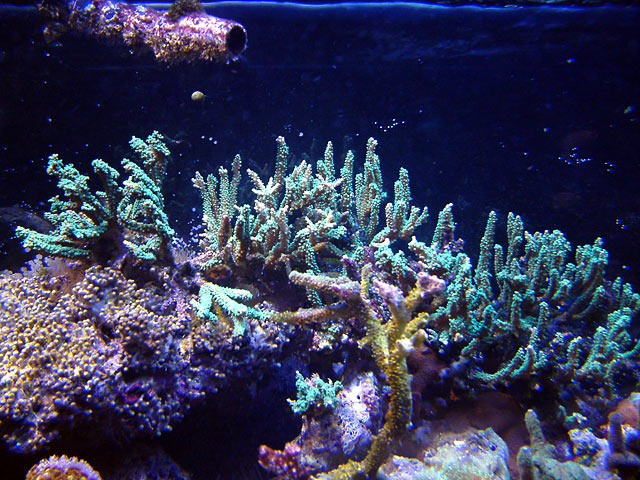   In your situation, I was thinking about a full teardown to clean it out and start fresh, rather than an upgrade. By pulling out the corals, keeping what you love, cleaning up the LR, scraping down the glass, and washing or replacing the sand, it would be possible to renew the health of your tank. The re-set would also allow you to work on new flow patterns in the tank, and open up areas you currently don't have for a new look, better light penetration, etc. It definitely would be a big job for a couple of days, but in the long run it would be a good idea. If you opt to do this, remember to keep your corals and all LR submerged as much as possible. Your LR will be full of sponges that can't be exposed to air, as their death will create a cycle of ammonia, nitrite and nitrate. If you move it quickly from the tank to a barrel of saltwater, you should be fine.
__________________
Marc Levenson - member of DFWMAS |
|
#10
|
|||
|
|||
|
Have you ever tried doing such a thing or you know someone who did it? Don't you think that in my system, where there already is a precarious balance, i will obtain only a disaster with many victims and this would equals to start a new system from zero? I imagine that operation to end in the scenario i've just described and it's only that the reason stopping me in doing such a thing. In particular when i'll move all rocks and corals i'll need many barrels because corals are over the LR and the movement will raise very much dust in the tank. What water should i put in the barrel? i don't think i could take out tank water, because before i'll take corals and LR outside in the barrel, it will take too much time. should i take apart the old water from water changes and use it in the barrels, leaving tha tank full? i guess it will be too hard, mainly because in the tank there are more LR+corals than water.
|
|
#11
|
|||
|
|||
|
Yes, I've had to deal with this a few times with some aging tanks that needed to be overhauled.
Since you are in Italy, some of the things I'm suggesting aren't quite what you can copy, but you'll get the main idea. When I say barrel, it can be cheap food-grade trashcans. In America, these are stamped with HDPE on the base, and trashcans are less than $10 each. One filled with 10 to 15g of water can hold quite a few corals, especially if you are using eggcrate (lighting diffuser) material to separate them from touching each other. Here's a picture that explains what I mean using a simple salt bucket. 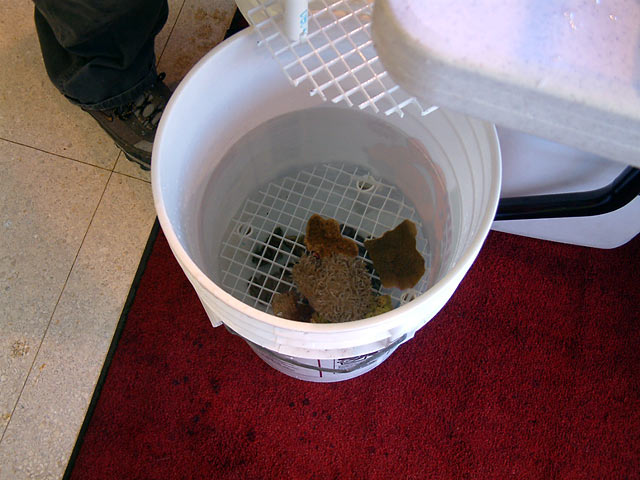 And in the background, pre-cut and stacked eggcrate (looks like a wedding cake): 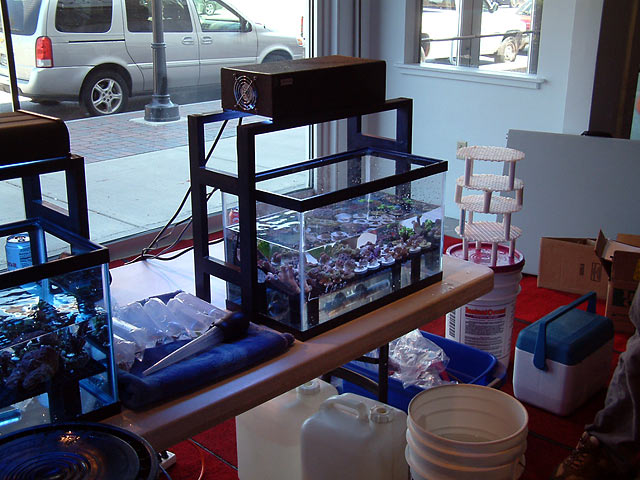 Make up a lot of new saltwater, and let it mix for a day or two near the tank. 60 - 75 gallons worth so you have enough. Drain some reeftank water into the barrel or bucket, and move corals over into that same water. You may need to add an airstone . heater, and/or small powerheads for some temporary circulation. Once all the corals are out of the tank, it is time to focus on the Live Rock. You may have some corals attached to the LR that you do not want to break off. In that case, it goes in another trashcan with saltwater (50% tank water/50% newly aged saltwater). Move it over quickly and angle the rock so the coral stays safe, especially if you have to do with with several rocks covered in coral. Again, a powerhead and maybe a heater might be necessary. Once you've removed all the LR and corals, it is simply time to clean up the tank. Siphon out all the sand and water, and clean the tank as best you can. I would take it outside, and carefully lay it on its front panel on a flat surface where it can't be nicked or damaged. Fill up a bucket with 4 gallons of tap water and 1/2 gallon of muriatic acid (add the acid to the water, not water to the acid)! and stir it around with some PVC. This is a caustic mixture stronger than vinegar and water. Put on gloves and eye protection. Pour some of that mixture into the tank to cover the front panel. In only needs to be enough to soak the glass, so a 1" layer is plenty. After 10 minutes, use a scraper, credit card, or piece of acrylic and scrape the front surface completely clean. What I do next is flip the tank over to let the back soak for a while with the same solution. If the water gets too dirty, pour it out and rinse the area well, as well as rinsing out the tank. Continue using more solution until the whole tank is clean. Don't get the solution on you, your face or your eyes (always wear eye protection). Once all 4 sides and the base of the tank are scraped clean, rinse it out well. Rinse down your work area well. (Muriatic acid eats away at calcium quickly, and can stain or bleach concrete so work in an area where you don't care what it looks like once done) Set the tank back in place, add new sand and refill it with saltwater. Using plastic on top of the sand keeps it from clouding the water as you fill the tank. Pour the water into a pitcher or vase, as I did below. 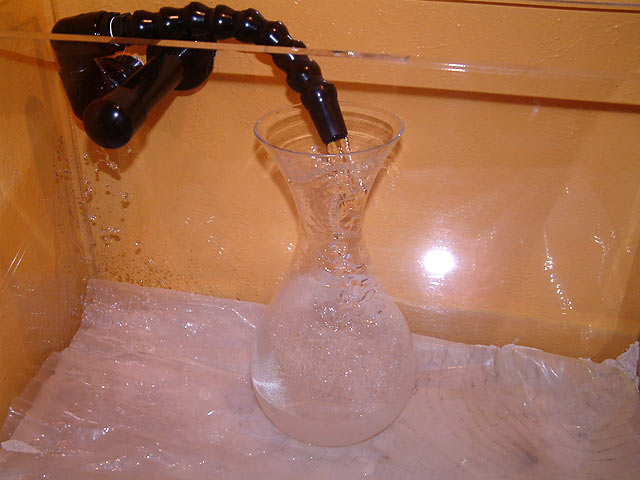 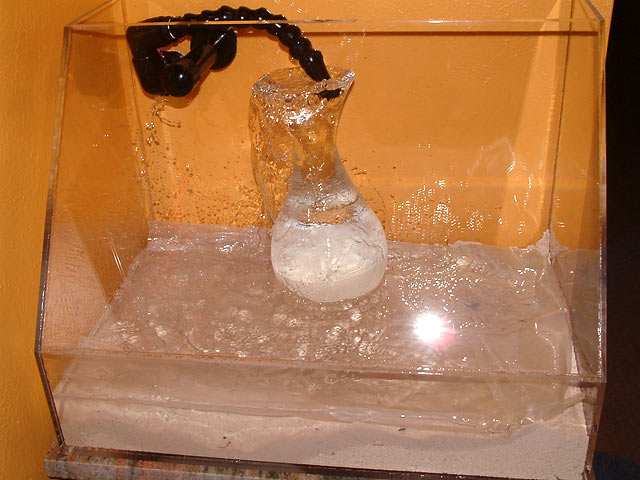 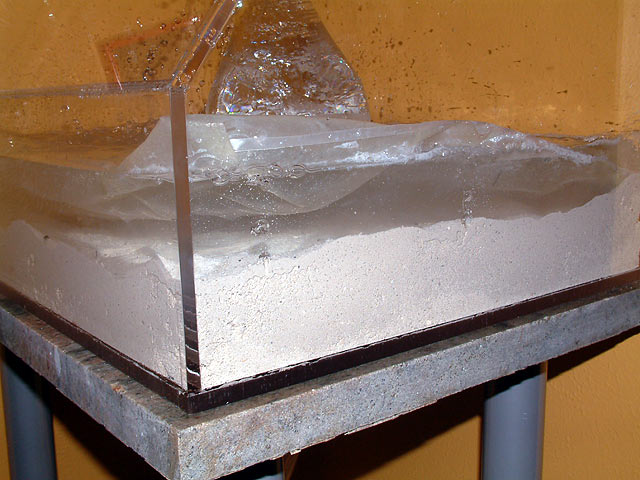 As long as the water is aged, had proper pH, temperature and salinity, I would just move the LR and corals into all new water and not "pollute" the clean system with old water. Any LR that has nuisance algae on it (or mushrooms or anything else you don't want), I would scrape, peel, and remove first. Shake the rock strongly in the barrel of water it was in. Then dip it in a second bucket of newly aged saltwater to shake out detritus, rinsing that rock. Now it can be placed in the tank. Repeat with all your LR. Get a cup or two of live sand from another hobbyist or your local fish store's display (or refugium) to seed your new sand bed. While you are doing all of this, I would have the powerheads soaking in the acid solution. In about 10 to 15 minutes they are ready to remove, rinse off and then bring inside for a thorough disassembly and cleaning. Add circulation back to the tank, orienting pumps to provide good flow without too much on certain corals, and clean up your mess. This would probably take up a good half day to accomplish. If possible get a helper. For the next few days, watch your livestock closely, and watch your equipment as well. Make sure everything is working like it should and that all settings and readings are as they should be.
__________________
Marc Levenson - member of DFWMAS Last edited by melev; 11/21/2007 at 02:39 PM. |
|
#12
|
|||
|
|||
|
Once again your explanation has been perfect also in minimal details. However it's more or less what i imagined i should have done. What i differently thought, was about using all new water in the new set up tank, because i've always thought and it has always been said to me that newly mixed water could be too aggressive with the animals, but if all parameters are ok, there should be no problem at all.
I don't know yet if i'll do it, i'm still thinking about a solution to perform an upgrading to tank size and, by the way, i'll surely will take some time to eveluate if the system will improve with the small expedient i adopted. As you surely well know, in our hobby we must have great patience. Now i'm surely pushed to a big changing because my tank appears to me not natural as it was some time ago, when corals were growing all over the rock. That is mainly caused by a recent changing i performed, due to overgrowing of certain species and corals haven't answered back with a growing both on tips and base, losing the natural appearance that a reef tank should have. For the moment, i still have to thank you for your readiness and helpfullness. Your advises will be surely helpful to me in a near or further future. |
|
#13
|
|||
|
|||
|
It sounds like you will think this through carefully before proceeding, and that is the main point I was hoping to get across. If you can anticipate the various things that could occur during your project, it will go smoothly.
Hopefully I provided you with enough information to cover the main points, but there are sure to be little things that will pop up during the actual event. Just don't rush what you are doing that day, nor cut corners. Don't use older products just because they aren't used up yet - rather replace those products with fresh ones to avoid creating new problems. That way the transition can be a smooth one, and help keep things stable for the livestock.
__________________
Marc Levenson - member of DFWMAS |
|
#14
|
|||
|
|||
|
Hello Melev,
I wanted to inform you that something is moving in my tank. I began to use activated carbon, a new RO/DI system and perform correct water changes and i must say that some new acropora tips is getting out. This is only a small sign, but i hope this will be the beginning of a continuous improvement. If everything will go as i plan (as you can see i'm already dreaming...), i think in a near future to begin with Zeovit system: i've seen with my eyes, some tank with this system and i've left them shaking my head because of their incredible beauty. |
|
#15
|
|||
|
|||
|
That's good news, hearing that your tank is taking a step in a positive direction.
There are several beautiful Zeovit systems over here as well. Several threads document how their reefs are doing on a regular basis.
__________________
Marc Levenson - member of DFWMAS |
|
|